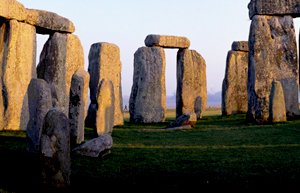Prehistoric Invaders of Britain
Great Britain has a history of invasions dating further back than virtually any other country in northern Europe. The first occurred some 700,000 years ago.
At the time, Britain was not yet an island, and the first human invaders came across a marshy land bridge which then joined the south of England to the coast of northern France. At that time, the climate was as balmy and warm as southern Europe is today, but it did not remain so for long.
The Devastation of the Ice Age
After the last of several Ice Ages closed in on one third of the Earth’s land area some 18,000 years ago, Britain was subjected to plunging temperatures and savage storms that killed off plants and the larger animals which had once provided humans with the food, skins, oil, bone and other resources they needed in order to live.
Conditions were so severe that Britain became unlivable for long periods of time. There was, in fact, a span of around 100,000 years when the British Isles appear to have been completely uninhabited. More clement, viable circumstances did not return for another 6,000 years or more.
The Ice Melts, the Humans Return
By then, the deep frozen ice sheets that once covered Europe as far south as Switzerland had melted. With its cooler, but more temperate climate, Britain became a more welcoming, more viable prospect for hunter-gatherers in search of prey and the rich pickings offered by its lush grasslands and deciduous forests.
From this time onwards, Britain has been continuously inhabited as hunters and later on, settlers, migratory mammoths, reindeer, horses and other animals seeking new grazing ground wandered across the land bridge which remained open for another 4,500 years. Then, melting ice raised the sea levels, the bridge was swamped and replaced by the waterway now known as the English Channel. With this, mainland Britain became an island.
Nomadic Hunters Roam Britain
By that time, Palaeolithic, or Old Stone Age, Britain had a population of perhaps a few hundred people. They were semi-nomadic, living in temporary shelters but always moving on with the herds of animals on which they relied for food. It was a hard, demanding life, full of danger and uncertainty, but these early Britons were, at least, able to find more than just the basics which they needed to survive.
There were red and roe deer and wild boar to be hunted, an abundance of plants to be gathered and rich stocks of fish to be caught along the northern and western coasts of Britain, where the warm waters of the Gulf Stream ran. There was ample flint, from which these Stone Age Britons could fashion simple, but effective tools for hunting, cutting, scraping and other domestic and technical purposes.
Skara Brae, a Neolithic Village Revealed
However, as time passed and the Old Stone Age gave way to the New, or Neolithic, some Britons were moving beyond the limited technology and simple culture of earlier times to provide themselves with a much more sophisticated and settled standard of living. Evidence, much more tangible than the fragmentary clues left behind by earlier Britons, was provided some 160 years ago by a fortuitous discovery at the Bay of Skaill on the west coast of Sandwick, one of the Orkney Islands off Scotland.
In the winter of 1850, exceptionally strong winds and high tides combined to strip the grass off a large mound known as Skerrabra to reveal, for the first time in over fifty centuries, the outlines of very ancient stone buildings. Subsequent excavations in 1868, 1925 and 1928-1930 uncovered a late Neolithic village which became known - and famous - as Skara Brae, lying beneath the sand dunes behind the Bay.
Sources
Pollard, Jason: Prehistoric Britain (Studies in Global Archaeology) Hoboken, New Jersey, Wiley-Blackwell, 2008. )
Beaumont, Comyns, The Riddle of Prehistoric Britain, Whitefish, Montana, Kessinger Publishing Company, 1997)
Website: BBC - History: British Prehistory http://www.bbc.co.uk/history/ancient/british_prehistory/

Don't stop there, keep the story coming please.
Nice article. Just an addition.
It is unfair to call our ancestors from 700,000 years ago humans since they are considerably different anatomically from modern humans. They are scientifically a different specie called "Homo erectus".